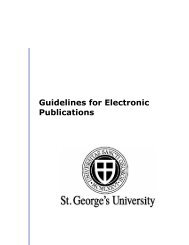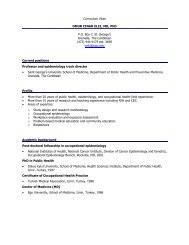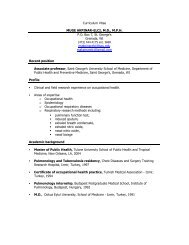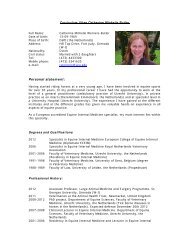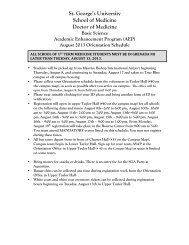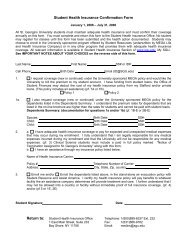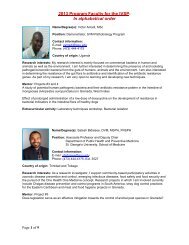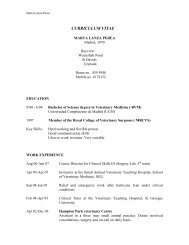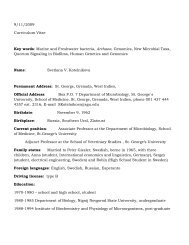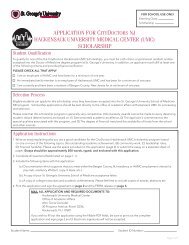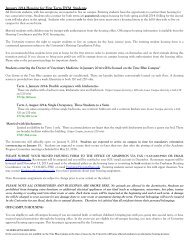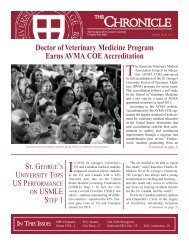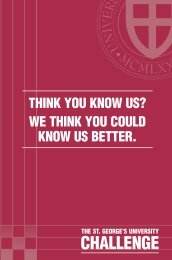SCHOOL OF 2012-2013 - St. George's University
SCHOOL OF 2012-2013 - St. George's University
SCHOOL OF 2012-2013 - St. George's University
Create successful ePaper yourself
Turn your PDF publications into a flip-book with our unique Google optimized e-Paper software.
equired to read current research and review articles (within<br />
the past 3 years) related to course content in order to gain<br />
experience in reading and interpreting scientific data and<br />
outcomes. Presentation of the course is concurrent with<br />
pathology, and the two courses are closely integrated,<br />
where feasible.<br />
• Lectures<br />
The didactic portion of the course is divided into two<br />
consecutive sections. The first covers basic principles<br />
of microbiology, including: classification and taxonomy,<br />
microbial physiology and genetics, microbial control,<br />
antibiotics, host-pathogen interactions and epidemiology.<br />
Bacterial, fungal, viral and other infectious agents are<br />
covered in this section. In the second section, human<br />
pathogens are discussed according to the organ system<br />
where they most often cause clinical disease. Clinical<br />
vignettes are used to illustrate the epidemiology,<br />
pathogenesis, virulence properties, symptoms, laboratory<br />
diagnosis and control of the infectious agents.<br />
• Laboratory<br />
Basic microbiological principles covered in lecture<br />
are reinforced by application in a laboratory setting.<br />
Laboratory work includes the basic principles of microbial<br />
staining, aseptic technique and isolation of infectious<br />
agents. <strong>St</strong>udents are exposed to many types of culture<br />
media, have the opportunity to perform throat cultures<br />
and obtain experience with rapid tests often administered<br />
during a clinical office visit.<br />
• Integrated Group Exercises<br />
Group exercises give students active experience in<br />
several areas of microbiology. <strong>St</strong>udents: 1) create and<br />
work through clinical cases 2) gain experience reading<br />
and interpreting both review and research articles in<br />
the scientific literature and 3) have the opportunity to<br />
develop team building, communication and<br />
presentation skills.<br />
MICR 580<br />
Medical Immunology<br />
This is a two credit course that has been developed to<br />
interdigitate with allied disciplines that are also offered<br />
during the student’s program of study. In particular, every<br />
attempt is made to ensure horizontal integration with<br />
Parasitology and vertical integration with Microbiology,<br />
which in turn, are integrated with Pathology through to<br />
Pathophysiology. The nature of Immunology demands<br />
that discipline-specific vocabulary be memorized<br />
before concepts may be understood and assimilated. A<br />
strong foundation is necessary to grasp the principles<br />
underlying clinical trials, clinical cases, diagnostic tests,<br />
and progressing immunological research. In addition to<br />
the aforementioned integration, the Immunology course<br />
emphasizes the manner by which basic science research<br />
translates into clinical practice. This is achieved by the<br />
incorporation of Translational Immunology within the<br />
series of didactic lectures.<br />
MICR 660<br />
Medical Parasitology<br />
Emphasis is balanced between parasitic infections that<br />
frequent the tropics and those that are being increasingly<br />
recognized in the temperate zones. Approximately half<br />
of the course deals with medical protozoology, including<br />
the amoebas, flagellates, ciliates, and sporozoa that are<br />
capable of infecting living human tissue. The second part<br />
of the course covers medical helminthology (the Nematoda,<br />
Platyhelminthes, and Acanthocephala). Arthropods of<br />
medical significance are also discussed. Presentations<br />
of the various organisms emphasize the epidemiology,<br />
symptomatology, pathogenesis, laboratory diagnosis, and<br />
treatment of each.<br />
• Laboratory<br />
Lectures are supplemented by laboratory sessions<br />
that include stool examinations for ova and cysts of<br />
parasites. Slide presentations are used extensively in the<br />
consideration of all the parasites.<br />
Pathology<br />
Shivayogi Bhusnurmath, MD, FRCPath, Co-Chair<br />
Bharti Bhusnurmath, MBBS, MD, Co-Chair<br />
PATH 640<br />
Pathology<br />
The Pathology course is taught in two segments—general<br />
pathology and systemic pathology. The main emphasis<br />
of the course is on active learning by students based<br />
on clinically oriented lectures and daily clinical problem<br />
solving by students in groups of 10 during lab hours. This<br />
is accomplished by targeted discussions using pathology<br />
images (about 400) representing patients and clinical<br />
vignettes with built-in questions. The images are posted<br />
School of Medicine<br />
Course Descriptions<br />
School of Medicine Catalog <strong>2013</strong>–2014 | 61



